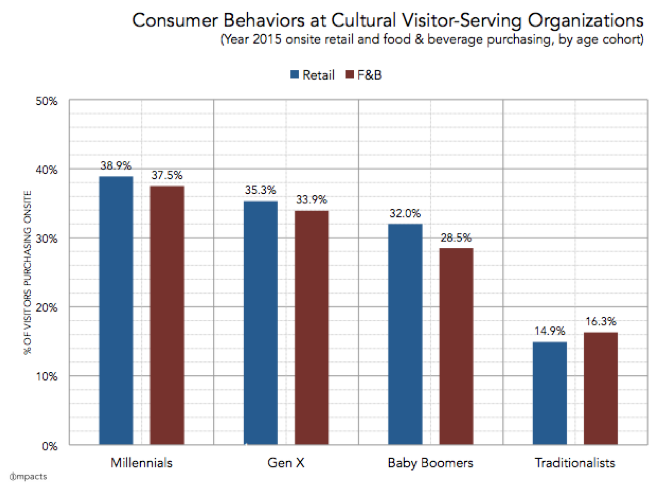Here’s what your organization needs to know about why this is happening.
This week’s Know Your Own Bone Fast Facts video takes a look at the onsite food, beverage, and retail purchasing habits of different generations at cultural organizations. You may be surprised by the findings.
Check out this chart from IMPACTS that is based on data from the ongoing National Awareness, Attitudes and Usage Study of 98,000 adults and counting. The chart indicates the respective percentages of visitors who make an onsite retail or food and beverage (F&B) purchase while visiting a cultural organization in the U.S.

Millennials spend more money than previous generations on retail and food while attending cultural organizations. As you can see, millennials are nearly 22% more likely to make an onsite retail purchase than are Baby Boomers, and they are 10% more likely to make a retail purchase than members of Generation X. Not only that, millennials are 32% more likely to eat on site while visiting than Baby Boomers, and 11% more likely to eat on-site than members of Generation X. Per capita millennial spending is 28% greater than that of Baby Boomers. That’s a big difference!
This information may be added to the important list of reasons why millennials are particularly awesome visitors to cultural organizations and why it’s incredibly important that organizations start reaching them at representative rates. The case for millennials being worth their bang for an organization’s-sustained-investment buck is growing stronger and stronger.
Why are millennials spending most and how can organizations utilize this information?
What we are seeing here is simply the applicability of broad trends affecting the cultural sector. Here are a few data-based factors that may be at play:
1) Millennials go out to eat more often than do other generations.
There are quite a few studies on this. And when we do go out to eat, we generally spend more money.
2) Millennials are more socially conscious consumers.
That said, this trend is also increasingly affecting all generations. This is relevant because most cultural organizations tend to be at least somewhat considerate about their food and beverage offerings. Think about the Monterey Bay Aquarium’s Seafood Watch, and other organizations with food options or initiatives focusing on local, sustainably sourced food in their cafes. In fact, food offerings with supporting narratives that underscore food ethics (and then put signs on the table, notes on the menu to help tell that story) tend to result in more sales than food options without a narrative.
3) Millennials were raised in an aggregated experience environment.
Instead of an individual store, we went to malls growing up and some of these malls had movie theaters, restaurants, bowling alleys, and climbing walls. “One-stop consuming” may be a concept that makes sense to this generation in this situation – and may be why some studies have even uncovered that millennials may prefer brick-and-mortar store shopping to online shopping when they can go. Not to mention, an aggregate environment makes things a whole lot easier for folks with small children.
Millennial trends are affecting our retail and food and beverage sales in a big way. Let’s harness the factors fueling this opportunity so that we can provide the best possible experiences for our visitors. Not to mention, let’s make the most of these opportunities so that we can secure additional funds to support our missions and operations.

